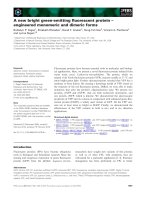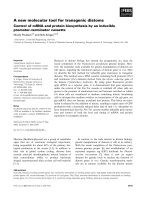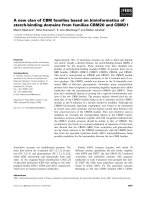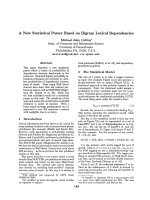Báo cáo sinh học: "A new Robertsonian translocation in Blonde d’Aquitaine cattle, rob(4;10)" pot
Bạn đang xem bản rút gọn của tài liệu. Xem và tải ngay bản đầy đủ của tài liệu tại đây (402.47 KB, 7 trang )
Original
article
A
new
Robertsonian
translocation
in
Blonde
d’Aquitaine
cattle,
rob(4;10)
I
Bahri-Darwich
EP Cribiu
1
HM
Berland
R
Darré
1
INRA,
Laboratoire
de
G6n6tique
Biochi9rcique
et
de
Cytog6n6tique,
Centre
de
Recherehes
de
Jouy-en-Josas,
78350
Jouy-en-Josas
Cedex;
2 É
cole
Nationale
Veterinaire
de
Toulouse,
URA-INRA
de
Cytogénétique
des
Populations,
23,
Chernin
des
Capelles,
31076
Toulouse
Cedex,
France
(Received
22
February
1993;
accepted
1
July
1993)
Summary -
The
cytogenetic
study
of
a
population
of
Blonde
d’Aquitaine
cattle
revealed
the
presence
of
a
Robertsonian
translocation.
The
chromosomes
involved
in
this
abnor-
mality
were
determined
using
G
(GTG),
R
(RBG)
and
C
(CBG)
banding
techniques.
The
chromosomes
in
question
were
identified
as
chromosomes
4
and
10.
The
existence
of
2
paternal
half-sisters
carrying
the
abnormality
suggests
that
it
originates
from
the
sire.
cattle
/
chromosome
/
Robertsonian
translocation
R.ésumé -
Une
nouvelle
translocation
chez
les
bovins
Blonde
d’Aquitaine,
rob(4;10).
L’étude
cytogénétique
d’une
population
de
bovins
Blonde
d’Aquitaine
a
permis
de
trouver
une
nouvelle
translocation
robertsonienne.
Les
chromosomes
impliqués
dans
cette
anomalie
ont
été
déterminés
à
l’aide
des
techniques
de
marquage
G
(GTG),
R
(RBG)
et
C
(CBG).
Les
chromosomes
concernés
sont
le
et
le
10.
L’existence
de
deux
vaches
porteuses
demi-
soeurs
de
père
indique
une
origine
vraisemblablement
paternelle
de
l’anomalie.
bovin
/
chromosome
/
translocation
robertsonienne
INTRODUCTION
Robertsonian
translocations
are
the
most
commonly
reported
chromosome
anoma-
lies
in
cattle;
the
most
widespread
is
the
1;29
translocation
detected
for
the
first
time
by
Gustavsson
and
Rockborn
(1964),
and
reported
later
with
high frequency
in
numerous
breeds
worldwide
(Popescu,
1977;
Popescu
and
Pech,
1991).
The
1;29
translocation
is
widespread
in
the
Blonde
d’Aquitaine
breed
since
the
frequency
of
the
heterozygous
and
homozygous
carriers
ranges
from
14
to
24%
(Queinnec
et
*
Correspondence
and
reprints
at,
1974;
Cribiu,
1985;
Frebling
et
at,
1987).
In
contrast,
as
in
other
breeds,
other
Robertsonian
translocations
have
been
reported
only
as
sporadic
cases
(Berland
et
at,
1988;
Cribiu
et
at,
1989).
The
present
report
describes
a
new
Robertsonian
translocation
observed
in
Blonde
d’Aquitaine
cattle.
MATERIALS
AND
METHODS
Animals
Karyotypes
were
prepared
from
one
phenotypically
normal
Blonde
d’Aquitaine
cow
carrying
the
new
translocation
(the
proband),
its
mother and
3
half-sisters
(1
maternal
half-sister
and
2
paternal
half sisters),
belonging
to
private
farms
near
Toulouse,
southwest
France.
The
pedigree
is
shown
in
figure
1.
Methods
The
karyotype
of
each
cow
was
determined
using
whole
blood
cultures
(Grouchy
et
al,
1964)
and
primary
skin
cell
cultures
(Chaffaux
et
al,
1986).
The
peripheral
blood
was
cultured
at
37°C
for
72
h
in
Ham’s
F12
medium
supplemented
with
20%
fetal
bovine
serum,
2
mM
glutamine,
100
pg/ml
streptomycin
and
concanavalin
A
(final
concentration:
0.1
yg/1).
Colcemid
(final
concentration:
0.03
mg/1)
was
added
to
the
culture
60
min
before
harvesting.
Tissue
biopsies
were
performed
under
local
anesthesia
on
the
rump.
Primary
fibroblast
cultures
were
initiated
from
skin
fragments,
disrupted
and
digested
in
a
trypsin
solution
(2.5
g/1)
and
grown
in
a
CO
2
incubator
as
monolayer
cultures
in
Falcon
dishes
(75
cm
2)
containing
a
medium
similar
to
that
previously
described
for
lymphocyte
cultures.
G-banding
was
achieved
using
a
modification
of
the
technique
of
Seabright
(1971).
The
C-bands
were
obtained
by
the
barium
hydroxide/saline/Giemsa
(BSG)
technique
(Summer,
1972).
To
induce
R-banding,
5-bromo-2-deoxyuridine
was
added to
the
medium
at
a
final
concentration
of
10
or
20
pg/ml.
The
cultures
were
incubated
at
37°C
until
the
number
of
mitotic
round
cells
reached
a
maximum,
about
8
to
9
h
after
BrdU
addition
(Hayes
et
al,
1991).
In
order
to
obtain
RBG-
bands,
the
cells
were
treated
according
to
the
procedure
described
by
Hayes
et
al
(1991)
and
fluorochrome-photolysis-Giemsa
(FPG)
staining
was
performed
as
described
by
Viegas-P6quignot
et
al
(1989).
The
chromosomes
were
identified,
paired
and
arranged
according
to
the
recom-
mendations
of
the
Reading
Conference
(1976)
and
the
ISCNDA
(1989).
RESULTS
In
classically
stained
metaphases,
the
karyotypes
of
the
cow
and
1
paternal
half-
sister
included
59
chromosomes:
the
2
X
chromosomes,
56
acrocentric
and
one
large
submetacentric
chromosome.
The
G-
and
R-bands
showed
that
chromo-
some
pairs
4
and
10
are
involved
in
the
translocation
(figs
2,
3).
The
C-banding
revealed
the
presence
of
2
constitutive
heterochromatin
blocks
in
the
pericentromeric
region
of
the
4;10
translocated
chromosome
(fig
4).
Among
the
other
3
animals
examined,
the
mother,
1
paternal
half-sister
and
1
maternal
half-sister
were
normal
with
a
diploid
chromosome
number
(2n)
of
60.
DISCUSSION
AND
CONCLUSION
This
chromosome
abnormality
is
the
fourth
Robertsonian
translocation
reported
in
the
Blonde
d’Aquitaine
breed.
The
first
translocation
was
the
1 ;29
translocation
which
is
known
to
have
a
wide
distribution
among
AI
bulls
(Queinnec
et
al,
1974)
and
heifers
(Frebling
et
al,
1987).
Chromosomes
implicated
in
the
second
and
third
translocations
were
identified
as
the
21
and
27,
and
the
9
and
23,
respectively
(Berland
et
al,
1988,
Cribiu
et
al,
1989).
These
2
rob(21;27)
and
rob(9;23)
have
been
observed
only
in
one
Blonde
d’Aquitaine)
bull
and
its
progeny
respectively.
Robertsonian
translocations
are
the
result
of
the
fusion
of
2
acrocentric
chromo-
somes.
Two
types
of
Robertsonian
translocations
have
been
described
in
the
Blond
d’Aquitaine
breed,
depending
on
the
presence
of
one
block
(1;29
translocation)
and
2
blocks
(21 ;27
and
9 ;23
translocation)
of
juxtacentromeric
constitutive
heterochro-
matin
revealed
by
the
CBG-banding
technique
(Berland
et
al,
1988;
Cribiu
et
al,
1989).
The
presence
of
these
2
blocks
would
suggest
the
mechanism
by
which
this
translocation
arose.
The
breakpoints
involved
the
short
arms,
which
are
extremely
limited
in
size,
of
both
chromosomes
4
and
10
in
the
centromeric
region;
the
fusion
gave
rise
to
a
submetacentric
chromosome
and
2
minute
fragments
(short
arms)
which
were
lost
during
the
subsequent
cell
divisions
(Eldridge,
1974).
The
origin
of
the
translocation
is
uncertain,
since
the
karyotype
of
the
sire
is
unknown.
It
is
probable
that
the
4;10
translocation
originated
from
the
sire
since
it
was
found
in
1
paternal
half-sister
and
not
in
the
mother and
the
maternal
half-sister.
As
with
a
majority
of
Robertsonian
translocations
found
in
animal
populations,
the
4;10
translocation
does
not
seem
to
be
associated
with
phenotypic
charac-
teristics.
In
the
absence
of
fertility
records,
a
reduced
fecundity
in
heterozygotes
resulting
from
anaphase
I
nondisjunction
and/or
changes
in
the
pattern
of
recombi-
nation
in
such
individuals,
cannot
be
excluded.
For
example,
the
1 ;29
translocation
produces
in
certain
breeds
a
reduced
fertility
in
the
daughters
of
carrier
bulls
(Gus-
tavsson
1969;
Refsdal
1976).
ACKNOWLEDGMENTS
The
assistance
of
G
Fabre
and
his
technical
staff
in
the
housing
and
handling
of
the
animals
at
the
Domaine
Experimental
de
Carmaux
(INRA)
is
gratefully
acknowledged.
We
thank
H
Hayes
for
her
advice
and
help
in
chromosomal
analysis
(INRA,
Laboratoire
de
G6n6tique
Biochimique
et
de
Cytogenetique).
REFERENCES
Berland
HM,
Sharma
A,
Cribiu
EP,
Darr6
R,
Bosher
J,
Popescu
CP
(1988)
A
new
case
of
Robertsonian
translocation
in
cattle.
J
Hered
79,
33-36
Chaffaux
S,
Cribiu
EP,
Crespeau
F
(1986)
Un
cas
rare
d’hermaphrodisme
vrai
lateral
chez
une
chienne
78,
XY.
Rec
Med
Vet
162,
463-470
Cribiu
EP
(1985)
Frequence
de
la
translocation
1/29
dans
les
centres
d’ins6mination
artificielle
fran!ais.
Elev
insémin
209,
17-22
_
Cribiu
EP,
Matejka
M,
Darr6
R,
Durand
V,
Berland
HM,
Bouvet
A
(1989)
Identification
of
chromosomes
involved
in
a
Robertsonian
translocation
in
cattle.
Genet
Sel
Evol 21,
555-560
.
Eldridge
FEA
(1974)
A
dicentric
Robertsonian
translocation
in
a
Dexter
cow.
J
Hered
65,
353-355
Frebling
J,
Foulley
JL,
Berland
HM,
Popescu
CP,
Cribiu
EP,
Darr6
R
(1987)
R6sultats
de
1’enquete
sur
la
fréquence
de
la
translocation
1/29
en
race
bovine
Blonde
d’Aquitaine.
Bull
Tech.
CRZV
Theix
INRA
67,
49-58
Grouchy
de
J,
Roubin
M,
Passage
E
(1964)
Microtechnique
pour
1’etude
des
chromosomes
humains
a
partir
d’une
culture
de
lymphocytes
sanguins.
Ann
G6n6t
7,
45
Gustavsson
I,
Rockborn
G
(1964)
Chromosome
abnormality
in
three
cases
of
lymphatic
leukemia
in
cattle.
Nature
(Lond)
203,
990
Gustavsson
I
(1969)
Cytogenetics,
distribution
and
phenotypic
effects
of
a
translo-
cation
in
Swedish
cattle.
Heredita.s
63,
68-169
Hayes
H,
Petit
E,
Dutrillaux
B
(1991)
Comparison
of
RBG-banded
Karyotypes
of
cattle,
sheep
and
goat.
Cytogenet
Cell
Genet
57,
51-55
ISCNDA
(1989)
International
System
for
Cytogenetic
Nomenclature
of
Domestic
Animals
(Di
Berardino
D,
Hayes
H,
Fries
H,
Long
S,
eds)
Cytogenet
Cell
Genet
53,
65-79
(1990)
Popescu
CP
(1977)
Les
anomalies
chromosomiques
des
bovins
(Bos
taurus
L).
ttat
actuel
des
connaissances
Ann
Genet
S61
Anim
9,
463-470
Popescu
CP,
Pech
A
(1991)
Une
bibliographie
sur
la
translocation
1/29
des
bovins
dans
le
monde
(1964-1990).
Ann
Zootech
40,
271-305
Queinnec
C,
Darr6
R,
Berland
HM,
Raynaud
JC
(1974)
Etude
de
la
transloca-
tion
1/29
dans
la
population
bovine
du
Sud-Ouest
de
la
France :
consequences
zootechniques.
In:
l
er
Congres
Mondial
de
Genetique
Appliqu6e
a
l’Elevage
Ani-
mal.
Madrid,
7-11
octobre;
Garsi,
Madrid,
131-151
Reading
Conference
(1976)
Proceedings
of
the
First
International
Conference
for
the
Standardization
of
Banded
Karyotypes
of
Domestic
Animals,
Reading,
August
2-6,
1976
(Ford
CE,
Pollock
DL,
Gustavsson
I,
eds)
Hereditas
92,
145-162
(1980)
Refsdal
AO
(1976)
Low
fertility
in
daughters
of
bulls
with
1/29
translocation.
Acta
Vet
Scand
17,
190-195
Seabright
M
(1971)
A
rapid
banding
technique
for
human
chromosomes.
Lancet
2,
971-972
Summer
AT
(1972)
A
simple
technique
for
demonstrating
centromeric
heterochro-
matin.
Exp
Cell
Res
75,
304-306
Vi6gas-P6quignot
E,
Dutrillaux
B.,
Magdelenat
H,
Coppey-Moisan
M
(1989)
Map-
ping
of
single
copy
DNA
sequences
on
human
chromosomes
by
in
situ
hybridization
with
biotinylated
probes:
enhancement
of
detection
sensitivity
by
intensified
fluo-
rescence
digital-imaging
microscopy.
Proc
Natl
Acad
Sci,
USA
86,
582-586









